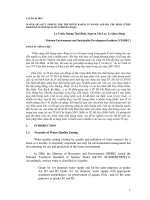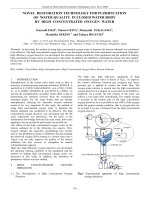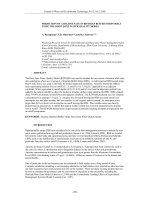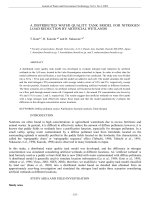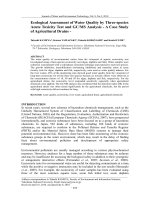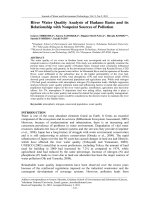National water quality handbook
Bạn đang xem bản rút gọn của tài liệu. Xem và tải ngay bản đầy đủ của tài liệu tại đây (7.12 MB, 368 trang )
National Water
Quality Handbook
September 2003
National Water Quality Handbook
Issued September 2003
Trade names mentioned are for specific information and do not constitute a
guarantee or warranty of the product by the Department of Agriculture or
an endorsement by the Department over other products not mentioned.
The U.S. Department of Agriculture (USDA) prohibits discrimination in all
its programs and activities on the basis of race, color, national origin, sex,
religion, age, disability, political beliefs, sexual orientation, or marital or
family status. (Not all prohibited bases apply to all programs.) Persons with
disabilities who require alternative means for communication of program
information (Braille, large print, audiotape, etc.) should contact USDA's
TARGET Center at (202) 720-2600 (voice and TDD).
To file a complaint of discrimination, write USDA, Director, Office of Civil
Rights, Room 326W, Whitten Building, 14th and Independence Avenue, SW,
Washington, DC 20250-9410 or call (202) 720-5964 (voice and TDD). USDA
is an equal opportunity provider and employer.
(450–VI–NWQH, September 2003)
National Water
Quality Handbook
Contents:
Part 600
Introduction
Part 601
Resource Management Framework
Part 602
Introduction to Water Quality
Part 603
Water Quality Assessment
Part 604
Nutrients
Part 605
Pathogens
Part 606
Pesticides
Part 607
Temperature
Part 608
Sediment
Part 609
Dissolved Oxygen
Part 610
Salts
Part 611
Heavy Metals
Part 612
Other Contaminants of Surface and Groundwater
Part 613
Reserved
Part 614
Design of Water Quality Monitoring Systems
Part 615
Analysis of Water Quality Monitoring Data
Part 616
Reserved
Part 617
Examples and Case Studies
Part 618
Reserved
Part 619
Glossary
(450–VI–NWQH, September 2003)
i
United States
Department of
Agriculture
National Water Quality Handbook
Part 600
Introduction
Part 600
Introduction
Natural
Resource
Conservation
Service
United States
Department of
Agriculture
National Water Quality Handbook
Natural
Resources
Conservation
Service
Part 600
Introduction to
National Water
Quality Handbook
Part 600
Contents:
Introduction to National
Water Quality Handbook
600.0000
Purpose of handbook
1
600.0001
Scope of handbook
1
600.0002
Intended audience
1
600.0003
Structure
1
600.0004
Key handbook support references
1
(450–VI–NWQH, September 2003)
i
Part 600
Introduction to National Water
Quality Handbook
600.0000 Purpose of handbook
600.0003 Structure
Water quality is an important natural resource concern
for the Nation. Being a lead natural resource technical
agency, the Natural Resources Conservation Service
(NRCS) has developed this handbook as a principal
reference pertaining to water quality as it relates to all
agricultural land uses. The handbook is the principal
NRCS reference document for technical information
and guidance in carrying out water quality responsibilities. This document consolidates pertinent procedures,
guidelines, and other materials to facilitate finding
relevant and reliable information. It provides clear
guidelines for filing and cross-referencing applicable
local, state, and national water quality related reference materials.
The National Water Quality Handbook consists of core
water quality information as well as extensive crossreferencing to NRCS documents and publications and
selected non-NRCS materials. Referenced documents
that support and contribute to the handbook are
referred to as Key References. The handbook leads the
user through a logical sequence beginning with basic
information and introductory material and progressing
through planning and implementation procedures for
more complex subjects. Key references are presented
to allow the user to pursue more in-depth information
than given in the handbook. A substantial part of the
handbook is available electronically on the NRCS
national Web page, () which
reflects updates, revisions, and the status of the document.
600.0001 Scope of handbook
The National Water Quality Handbook (NWQH) is
designed to provide guidance in all aspects of water
quality to NRCS personnel, Agency technical partners,
and those who provide technical services to clients for
NRCS. Guidance is provided to address water quality
issues within the NRCS planning and implementation
process. Agricultural related pollutants are addressed
within this document or through references to other
water quality technical materials.
600.0004 Key handbook support
references
This document and its specified support references are
listed in section I of the Field Office Technical Guide
(FOTG). Hardcopy materials of the NRCS National
Water Quality Handbook and key references reside in
each NRCS field office.
Key references
Specific technical or procedural details for planning,
such as conservation practice design criteria, are
beyond the scope of this handbook. Detailed design
information is retained in other NRCS handbooks and
manuals and is referred to in appropriate sections of
the NWQH. Also, water quality issues related to industrial and municipal waste pollutants are not within the
scope of this document.
600.0002 Intended audience
Agricultural Waste Management Field Handbook,
Rev. 1
Field Office Technical Guide (FOTG) Sections I–V
Ground Water and Surface Water, A Single Resource
USGS Circular 1139
National Agronomy Manual
National Engineering Handbook, Part 652, National
Irrigation Guide
National Planning Procedures Handbook
The focus of this handbook is the NRCS field office,
NRCS technical partners, and those providing technical services for NRCS. The NWQH includes technical
and procedural guidance that is applicable at any
organizational or technical level in support of NRCS
water quality activities. This handbook is appropriate
for basic orientation of NRCS water quality activities
as well as advanced procedures for technical specialists.
Stream Corridor Restoration—Principles, Processes,
and Practices (NEH Part 653)
(450–VI–NWQH, September 2003)
1
United States
Department of
Agriculture
National Water Quality Handbook
Natural
Resource
Conservation
Service
Resource Management
Framework
Part 601
Resource Management
Part 601
United States
Department of
Agriculture
National Water Quality Handbook
Natural
Resource
Conservation
Service
Part 602
Introduction to Water
Quality
Part 602
Intro to Water Quality
United States
Department of
Agriculture
National Water Quality Handbook
Natural
Resource
Conservation
Service
Part 603
Water Quality Assessment
Part 603
Water Quality Assessment
United States
Department of
Agriculture
National Water Quality Handbook
Natural
Resource
Conservation
Service
Part 604
Nutrients
Part 604
Nutrients
United States
Department of
Agriculture
National Water Quality Handbook
Part 605
Part 605
Pathogens
Natural
Resource
Conservation
Service
Pathogens
United States
Department of
Agriculture
National Water Quality Handbook
Natural
Resource
Conservation
Service
Pesticides
Part 606
Pesticides
Part 606
United States
Department of
Agriculture
National Water Quality Handbook
Natural
Resource
Conservation
Service
Part 607
Temperature
Part 607
Temperature
United States
Department of
Agriculture
National Water Quality Handbook
Natural
Resource
Conservation
Service
Part 608
Sediment
Part 608
Sediment
United States
Department of
Agriculture
National Water Quality Handbook
Natural
Resource
Conservation
Service
Part 609
Dissolved Oxygen
Part 609
Dissolved Oxygen
United States
Department of
Agriculture
National Water Quality Handbook
Part 610
Part 610
Salts
Natural
Resource
Conservation
Service
Salts
United States
Department of
Agriculture
National Water Quality Handbook
Natural
Resource
Conservation
Service
Heavy Metals
Part 611
Heavy Metals
Part 611
United States
Department of
Agriculture
National Water Quality Handbook
Natural
Resource
Conservation
Service
Part 612
Other Surface and Ground
Water Contaminants
Part 612
Other Contaminants
United States
Department of
Agriculture
National Water Quality Handbook
Natural
Resource
Conservation
Service
Part 613
Part 613
United States
Department of
Agriculture
National Water Quality Handbook
Natural
Resource
Conservation
Service
Part 614
Water Quality Monitoring
System Design
Part 614
WQM System Design
United States
Department of
Agriculture
National Water Quality Handbook
Natural
Resources
Conservation
Service
Part 614
Design of Water
Quality Monitoring
Systems
Preface
Purpose
The purpose of part 614 of the National Water Quality Handbook (NWQH)
is to describe methods for monitoring the water quality response to land
use and land management activities and conservation practices. These
methods include how to design a monitoring study, how to set up a monitoring station, and how to analyze the water quality data. The information
presented assumes that the reader has a basic understanding of water
quality. A basic knowledge of statistical analysis also is useful, although
part 615 of this handbook provides guidance in statistical analysis of water
quality data.
Part 614 of the NWQH is needed at this time because:
• The effectiveness of programmatic activities needs to be determined.
Water quality managers are constantly asking for evidence of the
results of a program.
• Comprehensive guidance is needed. Many water quality managers are
placed in the role of overseeing or designing monitoring projects, but
a comprehensive guidance is lacking.
• Several water quality monitoring projects currently underway may
require modification to show the results anticipated.
It is intended to assist those with direct or supervisory responsibilities in
planning, implementing, and evaluating water quality monitoring projects.
Structure of
part 614
This part of the NWQH is formatted to directly assist in designing a water
quality monitoring project. A 2-page worksheet using the steps in planning a
monitoring study is at the end of chapter 1. This worksheet was organized
to facilitate rapid and complete monitoring study design. Each step in the
worksheet corresponds to a separate chapter in part 614. Each chapter
includes examples to guide practice in applying the major concepts being
described.
Part 615 of the handbook is concerned with the statistical analysis of monitoring results. It may be useful to review the introductory chapter in part
615 to perform some of the statistical operations described in part 614.
Acknowledgments
Part 614 of the National Water Quality Handbook was written by John C.
Clausen, Ph.D., College of Agriculture and Natural Resources, University of
Connecticut. The concept for this project was developed by James N.
Krider, former national environmental engineer, Natural Resources Conservation Service (NRCS), Washington, DC. Technical leadership was
provided by Bruce J. Newton, limnologist, NRCS National Water and
Climate Center, Portland, Oregon, and by Frank Geter, agricultural engineer, formerly with the NRCS Information Technology Center, Fort Collins,
Colorado, and Douglas Holy, limnologist, Ecological Sciences Division,
Washington, DC.
(450–VI–NWQH, September 2003)
i
Many people contributed to this document. The following NRCS staff
served on teams that reviewed drafts of parts 614 and 615:
Stephanie Aschmann, agroecologist, Watershed Science Institute,
Lincoln, Nebraska
William H. Boyd, environmental engineer, National Water Management
Center, Little Rock, Arkansas
Richard Croft, water quality specialist, Watershed Science Institute,
Burlington, Vermont
Carl DuPoldt, agricultural engineer, Somerset, New Jersey
David C. Moffitt, envirnomental engineer, National Water Management
Center, Fort Worth, Texas
Gerald Montgomery, biologist, Northern Plains Regional Office, Lincoln,
Nebraska
James D. Rickman, (retired) agricultural engineer, Fort Worth, Texas
Lynn Sampson, biologist, East Lansing, Michigan
Ron Schierer, Northern Plains Regional Technical Team, Lakewood,
Colorado
Donald Stettler, (retired) agricultural engineer, National Water and Climate Center, Portland, Oregon
Howard Thomas, (retired) economist, Portland, Oregon
Barbara M. Vining, pesticide and nutrient specialist, formally of NRCS,
Indianapolis, Indiana
James Wood, water quality specialist, Burlington, Vermont
In addition, many attendees of a water quality monitoring workshop held in
1993 provided helpful input. They included Jerry M. Bernard, Denise A.
Tennessee, Gene Lindeman, and John Sutton. Other comments were
provided by Dana Chapman, Lyle J. Steffen, and Ivan Wilkinson.
Joseph A. Neafsey, water quality specialist, Storrs, Connecticut, was the
contract project officer. Mary R. Mattinson, editor, and Wendy R.
Pierce, illustrator, National Cartography and Geospatial Center, Fort
Worth, Texas, provided editorial and graphic support.
The National Water Quality Handbook is the result of a collaborative effort
of the NRCS Science and Technology Consortium. Special thanks to the
following individuals for their leadership and support in the development
and publishing of this essential technical reference:
Wil Fontenot, natural resource specialist, Lafayette, Louisianna
Jon Werner, national hydrologist, Conservation Engineering Division,
Washington, D.C.
Roy Mann, (retired) resource conservationist, Portland, Oregon
Ken Pfeiffer, pest management specialist, National Water and Climate
Center, Portland, Oregon
Bruce Newton, acting director, National Water and Climate Center, Portland, Oregon
Lynn Betts, communications director, Wildlife Habitat Management Institute, Des Moines, IA
ii
(450–VI–NWQH, September 2003)
Part 614
National Water Quality
Handbook
Contents:
Chapter 1
Introduction
Chapter 2
Water Quality Problem
Chapter 3
Objectives
Chapter 4
Statistical Designs
Chapter 5
Scale of Study
Chapter 6
Variable Selection
Chapter 7
Sample Type
Chapter 8
Sampling Location
Chapter 9
Sampling Frequency and Duration
Chapter 10
Station Type
Chapter 11
Sample Collection and Analysis
Chapter 12
Land Use and Management Monitoring
Chapter 13
Data Management
Appendixes
Index
(450–VI–NWQH, September 2003)
iii

